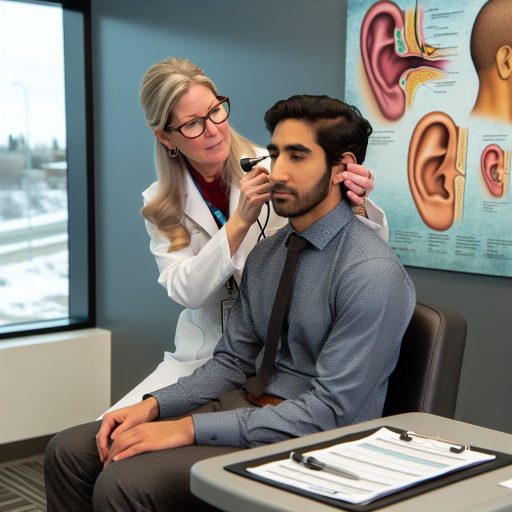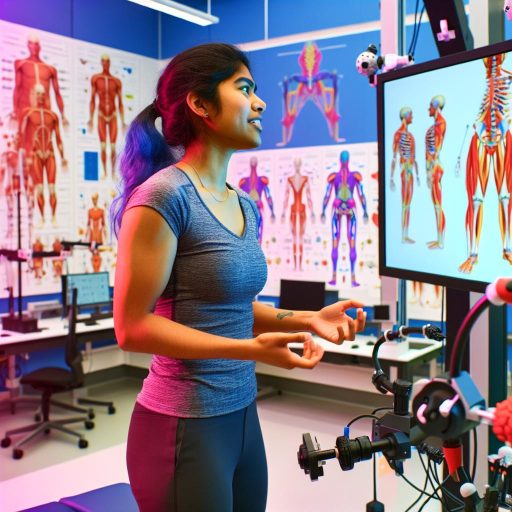Understanding Communication Disorders: Types and Challenges
Types of Communication Disorders
Communication disorders vary widely among individuals.
These disorders may include speech, language, and hearing challenges.
Common types are articulation disorders, fluency disorders, and voice disorders.
Articulation disorders involve difficulty pronouncing sounds correctly.
Fluency disorders affect the flow of speech, such as stuttering.
Voice disorders impact the quality, pitch, and volume of speech.
Furthermore, language disorders may include difficulties with understanding or using language.
Challenges Faced by Individuals
Individuals with communication disorders often face significant challenges.
Social interactions can become difficult, leading to feelings of isolation.
Additionally, academic and occupational performance may decline without proper support.
Understanding barriers is essential for effective intervention.
For instance, anxiety may arise during communication attempts.
Moreover, self-esteem issues frequently accompany these disorders.
The Role of Speech-Language Pathologists
Speech-language pathologists play a critical role in addressing these disorders.
They assess, diagnose, and create treatment plans tailored to individual needs.
Therapy may involve exercises to improve speech clarity or enhance language skills.
Moreover, they educate families on effective communication strategies.
Collaborative support is crucial for successful outcomes.
Understanding Communication Disorders
Understanding the types and challenges of communication disorders is vital.
Speech-language pathologists are essential in promoting effective communication.
Through their expertise, individuals can overcome barriers and improve their social interactions.
Educational Requirements
Relevant Degrees
To become a speech-language pathologist, you need a master’s degree in communication sciences and disorders.
This advanced degree provides essential training in speech and language development.
Additionally, many programs include supervised clinical practice, which is crucial for hands-on experience.
Furthermore, some candidates opt for doctoral degrees to enhance their expertise and career opportunities.
Unlock Your Career Potential
Visualize a clear path to success with our tailored Career Consulting service. Personalized insights in just 1-3 days.
Get StartedCertification Requirements
After earning a degree, obtaining certification is vital for professional practice.
Most states require the Certificate of Clinical Competence in Speech-Language Pathology, known as CCC-SLP.
This certification is granted by the American Speech-Language-Hearing Association (ASHA).
Moreover, continuing education is necessary to maintain certification and stay updated with the field.
State Licensure
Each state has its own licensure requirements for speech-language pathologists.
Typically, you must pass a national examination in speech-language pathology.
Additionally, many states require a specific number of supervised clinical hours before granting a license.
Continuing Education
Speech-language pathologists must engage in continuing education to retain their license and certification.
This ongoing education helps professionals stay informed about new research and techniques.
Often, participation in workshops and conferences is encouraged for professional growth.
Key Soft Skills
Empathy
Empathy allows speech-language pathologists to connect with clients on a personal level.
This skill helps professionals understand the challenges clients face.
By putting themselves in their clients’ shoes, they foster trust and rapport.
Furthermore, empathetic practitioners can tailor their approaches to individual needs.
This customization often leads to more effective therapy outcomes.
Patience
Patience is essential in the field of speech-language pathology.
Progress may be slow due to the complexities of communication disorders.
A patient therapist remains calm and supportive throughout the process.
This attitude helps clients feel secure in their learning environment.
Moreover, patience allows therapists to provide consistent feedback and encouragement.
Active Listening
Active listening is a fundamental skill for speech-language pathologists.
This skill involves fully concentrating on what clients say.
It enables professionals to gather important information about clients’ needs.
Additionally, active listening fosters a supportive dialogue between the therapist and client.
Effective communication hinges on this interactive exchange of ideas.
Gain More Insights: Challenges Speech-Language Pathologists Often Face
Assessment Skills
Understanding Evaluation Techniques
Effective assessment is critical in speech-language pathology.
This skill helps identify individual speech and language needs.
Moreover, it guides treatment planning and intervention strategies.
Standardized Tests
Standardized tests measure specific speech and language abilities.
These assessments provide reliable comparisons against normative data.
Examples include the Peabody Picture Vocabulary Test and the Goldman-Fristoe Test of Articulation.
Dynamic Assessment
Dynamic assessment focuses on a learner’s potential for change.
This approach evaluates how well clients can learn new skills.
It highlights not only current abilities but also areas for growth.
Behavioral Observations
Observing client interactions contributes valuable data.
By watching real-life communication, pathologists can assess practical skills.
This technique often reveals discrepancies not seen in formal testing.
Interviews and Questionnaires
Gathering information from clients and their families is essential.
Interviews provide insights into communication challenges and successes.
Questionnaires can identify areas of concern reported by caregivers.
Collaboration with Other Professionals
Working with educators and healthcare providers enhances assessments.
Collaboration ensures a comprehensive view of the client’s needs.
It fosters a multidisciplinary approach to speech and language evaluation.
Discover More: Challenges And Rewards Of Being An Audiologist
Therapeutic Skills: Designing and Implementing Treatment Plans
Understanding Client Needs
Speech-language pathologists start by assessing their clients’ needs.
They conduct detailed evaluations to identify specific challenges.
Furthermore, they gather information from clients and caregivers.
Setting Goals
Once needs are assessed, setting clear goals becomes essential.
These goals should be specific, measurable, achievable, relevant, and time-bound.
Collaboration with clients helps ensure goals align with their desires.
Creating Customized Treatment Plans
Each treatment plan must be tailored to the individual client.
Pathologists include various techniques and resources in these plans.
They consider the client’s age, communication style, and culture.
Moreover, innovative strategies enhance client engagement and participation.
Implementing Treatment Strategies
Implementation requires focused and dynamic interaction with clients.
Pathologists should monitor progress closely during sessions.
Additionally, they use a variety of tools, including games and activities.
These resources make the learning process enjoyable and effective.
Evaluating Progress
Regular evaluation of client progress is crucial for effective treatment.
Pathologists must adjust treatment plans based on evaluation results.
They should provide clear feedback to clients and their families.
Collaborating with Other Professionals
Speech-language pathologists often work alongside other healthcare providers.
This collaboration enhances the overall support for the client.
Regular communication helps align goals and strategies across disciplines.
Furthermore, it fosters a comprehensive approach to client care.
Delve into the Subject: Understanding the Scope of Kinesiology in Health Care

Interdisciplinary Collaboration: Working with Other Health Professionals
The Importance of Teamwork
Effective collaboration enhances patient care outcomes.
Speech-language pathologists often work with a variety of health professionals.
Teamwork fosters a comprehensive approach to treatment.
Key Health Professionals to Collaborate With
Collaboration occurs with several key health professionals.
- Physicians play a crucial role in diagnosing and managing health conditions.
- Occupational therapists contribute to cognitive and physical rehabilitation.
- Psychologists assist in addressing mental health aspects.
- Dietitians provide insights into nutrition that affect speech and swallowing.
Benefits of Interdisciplinary Collaboration
Collaboration provides a broader perspective on patient needs.
Each professional brings unique expertise to the table.
This approach enhances communication strategies for patients.
Moreover, it ensures a more holistic treatment plan.
Strategies for Effective Collaboration
Building strong relationships is essential in interdisciplinary teams.
Regular meetings enhance communication among team members.
Sharing patient progress updates keeps everyone informed.
Furthermore, establishing clear roles helps avoid misunderstandings.
Challenges in Collaboration
Despite benefits, challenges may arise in collaboration.
Differences in professional jargon can lead to miscommunication.
Time constraints may hinder effective teamwork.
Additionally, varying approaches to care can create conflict.
Overcoming Collaboration Barriers
Open communication is vital to overcoming barriers.
Utilizing technology facilitates coordination among team members.
Setting common goals helps unify the collaboration effort.
Finally, ongoing training in collaborative practices enhances team effectiveness.
You Might Also Like: Advanced Technologies Used by Modern Podiatrists
Cultural Competence: Addressing Diverse Needs in Speech Therapy
Understanding Cultural Competence
Cultural competence is essential in speech therapy practice.
It equips professionals to work effectively with diverse populations.
Furthermore, therapists must recognize unique cultural backgrounds.
This recognition fosters better communication and understanding.
Importance of Cultural Awareness
Cultural awareness enhances the therapeutic relationship.
It helps therapists appreciate clients’ perspectives and values.
This understanding leads to tailored and effective treatment plans.
Moreover, it minimizes misunderstandings during therapy sessions.
Strategies for Developing Cultural Competence
- Engage in ongoing education about different cultures.
- Attend workshops focused on diversity in speech therapy.
- Participate in community outreach programs.
- Seek feedback from clients and their families.
- Collaborate with culturally diverse colleagues.
Implementing Cultural Practices in Therapy
Therapists should incorporate culturally relevant materials in sessions.
Using familiar examples facilitates easier understanding.
Additionally, respecting language preferences is crucial.
This inclusion promotes client comfort and engagement.
Continuous Improvement
Cultural competence is an ongoing journey for every speech-language pathologist.
Regular self-reflection helps identify areas for growth.
Moreover, staying updated on cultural trends benefits therapeutic practices.
Ultimately, commitment to cultural competence can improve outcomes for all clients.
Technology Proficiency: Using Tools and Resources for Speech Therapy
The Importance of Technology in Speech-Language Pathology
Technology plays a crucial role in speech-language pathology.
It enhances communication methods for clients.
Moreover, it provides diverse tools for assessment and intervention.
Common Tools Used in Speech Therapy
Various tools help therapists improve client outcomes.
Speech therapy software offers interactive exercises for practice.
- Articulation apps support clear speech articulation.
- Language development tools help build vocabulary.
- Assessment programs streamline the evaluation process.
Best Practices for Using Technology
Utilizing technology effectively requires a strategic approach.
Therapists should choose tools that align with client needs.
Additionally, they must stay updated on technological advancements.
Regular training can enhance technology proficiency.
Networking with peers can provide insightful resources.
Challenges Associated with Technology
Despite its benefits, technology introduces challenges.
Accessibility can be an issue for some clients.
Moreover, navigating new software might overwhelm therapists.
Therapists must find solutions to overcome these hurdles.
The Future of Technology in Speech Therapy
Looking ahead, technology will likely evolve significantly.
Advancements in artificial intelligence may improve therapy options.
Furthermore, teletherapy continues to gain popularity.
These changes can enhance accessibility and effectiveness.




